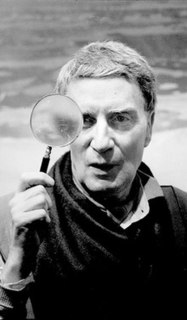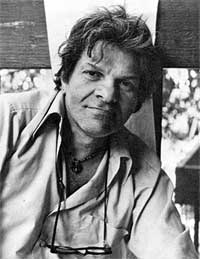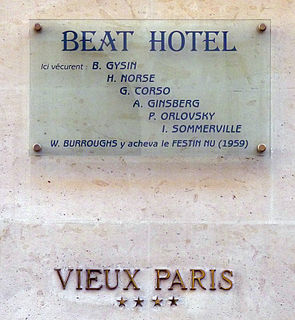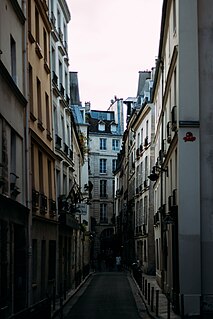Harold Stephen Chapman (born 26 March 1927) [1] (died 19 August 2022) is a photographer noted for chronicling the 1950s in Paris.
Harold Stephen Chapman (born 26 March 1927) [1] (died 19 August 2022) is a photographer noted for chronicling the 1950s in Paris.
Chapman was born in Deal, in Kent. [1] He produced a large body of work over many years, with his most significant period from the mid-1950s to the early 1960s, when he lived in a backstreet Left Bank guesthouse in Paris later nicknamed (by Verta Kali Smart) ‘the Beat Hotel’. There he chronicled in detail the life and times of his fellow residents – among them Allen Ginsberg [1] and Allen's lover Peter Orlovsky, William S. Burroughs, Gregory Corso, Sinclair Beiles, Brion Gysin, Harold Norse, and other great names of Beat Generation poetry and art. When the Beat Hotel closed its doors in 1964, Chapman was the last guest to leave. The collection of photographs he had taken there provide an artistic and historic record, and became the mainstay of his reputation.
His other works attract worldwide attention, and include portraits, landscapes, bizarre objets trouvés and, especially, distinctive enigmatic street scenes (often involving incongruous background advertising) that combine his two characteristic emotions: pervasive moody anxiety and quirky wit. His work is represented by photographic agency, TopFoto. [2]

Brion Gysin was a British-Canadian painter, writer, sound poet, performance artist and inventor of experimental devices.
The cut-up technique is an aleatory literary technique in which a written text is cut up and rearranged to create a new text. The concept can be traced to at least the Dadaists of the 1920s, but was popularized in the late 1950s and early 1960s by writer William S. Burroughs. It has since been used in a wide variety of contexts.

William Seward Burroughs II was an American writer and visual artist, widely considered a primary figure of the Beat Generation and a major postmodern author who influenced popular culture and literature. Burroughs wrote eighteen novels and novellas, six collections of short stories and four collections of essays, and five books have been published of his interviews and correspondences; he was initially briefly known by the pen name William Lee. He also collaborated on projects and recordings with numerous performers and musicians, made many appearances in films, and created and exhibited thousands of visual artworks, including his celebrated "Shotgun Art".
The Beat Generation was a literary movement started by a group of authors whose work explored and influenced American culture and politics in the post-war era. The bulk of their work was published and popularized by Silent Generationers in the 1950s. The central elements of Beat culture are the rejection of standard narrative values, making a spiritual quest, the exploration of American and Eastern religions, the rejection of economic materialism, explicit portrayals of the human condition, experimentation with psychedelic drugs, and sexual liberation and exploration.

Gregory Nunzio Corso was an American poet and a key member of the Beat movement. He was the youngest of the inner circle of Beat Generation writers.

The Beat Hotel was a small, run-down hotel of 42 rooms at 9 Rue Gît-le-Cœur in the Latin Quarter of Paris, notable chiefly as a residence for members of the Beat poetry movement of the mid-20th century.

Mohamed Hamri, commonly known as Hamri, was a Moroccan painter and author. Self-described as "The painter of Morocco," Hamri was one of the few Moroccans to participate in the Tangier Beat scene.

Antony Balch was an English film director and distributor, best known for his screen collaborations with Beat Generation author William S. Burroughs in the 1960s and for the 1970s horror film, Horror Hospital.

Ira Cohen was an American poet, publisher, photographer and filmmaker. Cohen lived in Morocco and in New York City in the 1960s, he was in Kathmandu in the 1970s and traveled the world in the 1980s, before returning to New York, where he spent the rest of his life. Cohen died of kidney failure on April 25, 2011. Ira Cohen's literary archive now resides at the Beinecke Rare Book and Manuscript Library, Yale University.

Harold Norse was an American writer who created a body of work using the American idiom of everyday language and images. One of the expatriate artists of the Beat generation, Norse was widely published and anthologized.

The Dreamachine is a stroboscopic flickering light art device that produces eidetic visual stimuli. Artist Brion Gysin and William S. Burroughs' "systems adviser" Ian Sommerville created the Dreamachine after reading William Grey Walter's book, The Living Brain.
Dead City Radio is a musical album by Beat Generation author William S. Burroughs, which was released by Island Records in 1990. It was dedicated to Keith Haring.

Sinclair Beiles was a South African beat poet and editor for Maurice Girodias at the Olympia Press in Paris. He developed along with William S. Burroughs and Brion Gysin the cut-up technique of writing poetry and literature.

The Third Mind is a book by Beat Generation novelist William S. Burroughs and artist/poet/novelist Brion Gysin. First published in a French-language edition in 1977, it was published in English in 1978. It contains numerous short fiction pieces as well as poetry by Gysin, and an interview with Burroughs. Some chapters had previously been published, in slightly different form, in various literary journals between 1960 and 1973.
Frank Rynne is an Irish-born singer, record producer, art curator, film-maker, writer, and historian. He has played in three bands Those Handsome Devils in 1984, The Baby Snakes (1985-1994) and Islamic Diggers. He has produced three CDs of Moroccan folk music by the Master Musicians of Joujouka. In 1992 Rynne co-organised The Here to Go Show, an international art show featuring the works of William S. Burroughs and Brion Gysin and, with fellow organisers Joe Ambrose and Terry Wilson, co-wrote Man from Nowhere. He co-produced the CD 10%: file under Burroughs (1996).
This is a bibliography of the works of William S. Burroughs.

Ian Sommerville was an electronics technician and computer programmer. He is primarily known through his association with William S. Burroughs's circle of Beat Generation figures, and lived at Paris's so-called "Beat Hotel" by 1960, when they were regulars there, becoming Burroughs's lover and "systems adviser".

Call Me Burroughs is a spoken word album by Beat Generation author William S. Burroughs, which was released on LP by The English Bookshop, Paris, in June 1965, and then issued in the United States by ESP-Disk, New York, in 1966. Rhino Word Beat reissued the album on Compact Disc in 1995, the company's first ever reissue.

Burroughs: The Movie is a 1983 documentary film directed by Howard Brookner about the beat generation writer William S. Burroughs.

Rue Gît-le-Cœur is a street in the 6th arrondissement of Paris, France.
3. https://issuu.com/thedealdespatch/docs/dd_1_summer_13july